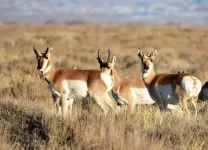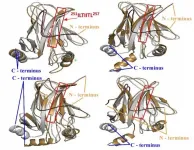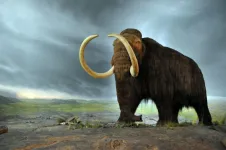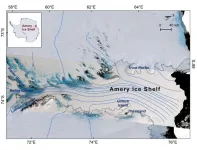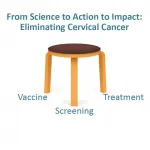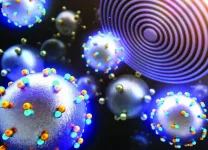(Press-News.org) Humans and animals alike constantly size up one another. In the workplace, a new employee quickly learns which coworkers are the most respected -- and therefore hold more power. Big brothers boss around little brothers. In nature, a dominant male chimpanzee fights off would-be intruders. Even fish and octopi interact within social hierarchies.
These pecking orders have been studied within the behavioral ecology world for almost 100 years. How individuals interact can affect access to food and mates -- even survival -- and insights into those behaviors can lead to better management of threatened and endangered populations. But few studies have explored what the animals that live within these dominance hierarchies actually know about each other. The more animals know about each other, the more they may be able to optimize their aggression. New research, published March 3 in PNAS, offers the first big-picture look at information in these animal systems.
Using a new computational method, the researchers examined existing data on aggression -- the earliest from a 1934 pigeon study -- in 172 social groups across 85 species in 23 orders, looking for social dominance patterns. They found three main aggression strategies employed by individuals: simply fighting any lower-ranked opponents; specializing in fighting "close competitors" ranked just below themselves; and bullying opponents ranked much lower. The majority of the groups fell into the first category, where aggression could be explained by animals following a basic dominance hierarchy, but several groups used the more information-rich close competitors or bullying strategies to fine-tune their choice of opponents.
Rank clearly influences how one individual treats another, says biologist Elizabeth Hobson, the lead author of the study. She is currently an Assistant Professor at the University of Cincinnati and was formerly a Complexity Postdoctoral Fellow at the Santa Fe Institute, where she conducted much of the research.
"What we're able to do with our computational approach is to get new insight into how animals are managing conflict within the groups, and the kind of information that informs those decisions," she says. Simon DeDeo of Carnegie Mellon University and the Santa Fe Institute and Dan Mønster of Aarhus University in Denmark also contributed to the work.
Some of the results took the team by surprise. For example, it turns out that pronghorn -- a speedy North American ungulate prized for its graceful gait -- can be bullies. "They look so cute, right?" says Hobson. "You don't expect them to have a bullying strategy in their group."
Another unexpected insight was that social dominance patterns can vary from group to group within the same species. For example, one group of African elephants behave according to a close competitor hierarchy, while another group exhibits bullying behavior.
It's unclear why dominance strategies sometimes differ among groups, but this and other studies suggest that they can change according to the context in which individuals interact.
For example, "it may be that you have near rivals, so you might have to have conflict to sort that out," DeDeo says.
Hobson says she hopes the study will inspire other researchers to look at how social information is used within and across species. This could provide a foundation for answering even bigger questions about how social complexity arises in animals, and how animals evolved the cognitive skills to enact these social dominance patterns.
INFORMATION:
HOUSTON - (March 4, 2021) - A mutation that replaces a single amino acid in a potent tumor-suppressing protein turns it from saint to sinister. A new study by a coalition of Texas institutions shows why that is more damaging than previously known.
The ubiquitous p53 protein in its natural state, sometimes called "the guardian of the genome," is a front-line protector against cancer. But the mutant form appears in 50% or more of human cancers and actively blocks cancer suppressors.
Researchers led by Peter Vekilov at the University of Houston (UH) and Anatoly Kolomeisky at Rice University have discovered the same mutant protein can aggregate into clusters. These in turn nucleate the formation of amyloid fibrils, a ...
As you scroll through Amazon looking for the perfect product, or flip through titles on Netflix searching for a movie to fit your mood, auto-generated recommendations can help you find exactly what you're looking for among extensive offerings.
These recommender systems are used in retail, entertainment, social networking and more. In a recently published study, two researchers from The University of Texas at Dallas investigated the informative role of these systems and the economic impacts on competing sellers and consumers.
"Recommender systems have become ubiquitous in e-commerce platforms and ...
Woolly mammoths may have walked the landscape at the same time as the earliest humans in what is now New England, according to a Dartmouth study published in END ...
ALBUQUERQUE, N.M. -- Using thin films -- no more than a few pieces of notebook paper thick -- of a common explosive chemical, researchers from Sandia National Laboratories studied how small-scale explosions start and grow. Sandia is the only lab in the U.S. that can make such detonatable thin films.
These experiments advanced fundamental knowledge of detonations. The data were also used to improve a Sandia-developed computer-modeling program used by universities, private companies and the Department of Defense to simulate how large-scale detonations initiate and propagate.
"It's neat, we're really pushing the limits on the ...
When a block of ice the size of Houston, Texas, broke off from East Antarctica's Amery Ice Shelf in 2019, scientists had anticipated the calving event, but not exactly where it would happen. Now, satellite data can help scientists measure the depth and shape of ice shelf fractures to better predict when and where calving events will occur, according to researchers.
Ice shelves make up nearly 75% of Antarctica's coastline and buttress -- or hold back -- the larger glaciers on land, said Shujie Wang, assistant professor of geography at Penn State. If the ice shelves were to collapse and Antarctica's glaciers fell ...
Amsterdam, March 4, 2021 - Cervical cancer is a serious global health threat which kills more than 300,000 women every year. It's a disease that disproportionately affects women in low- and middle-income countries in equatorial Africa, Latin America and Southeast Asia, yet it is a preventable disease and decades of research have produced the tools needed to eliminate it.
Recognizing this urgent public health issue, the editorial team of Preventive Medicine, led by Editor-in-Chief Dr. Eduardo Franco, Director, Division of Cancer Epidemiology and Chair, Gerald Bronfman Department of Oncology at McGill University, is publishing a special issue titled "From Science to Action to ...
Researchers at the Earlham Institute (EI) have created a new automated workflow using liquid handling robots to identify the genetic basis to prevent plant pathogens, which can be used on a much larger and rapid scale than current methods.
The new EI Biofoundry automated workflow gives scientists an enhanced visual check of genetic mutations linked to the control of crop disease, speeding up analysis to a fraction of the time compared to current methods - from months to weeks - accelerating development of novel products for crop protection in the agricultural industry.
Biosynthesis is the formation of chemical compounds by a living organism, ...
COSMIC, a multipurpose X-ray instrument at Lawrence Berkeley National Laboratory's (Berkeley Lab's) Advanced Light Source (ALS), has made headway in the scientific community since its launch less than 2 years ago, with groundbreaking contributions in fields ranging from batteries to biominerals.
COSMIC is the brightest X-ray beamline at the ALS, a synchrotron that generates intense light - from infrared to X-rays - and delivers it to dozens of beamlines to carry out a range of simultaneous science experiments. COSMIC's name is derived from coherent scattering and microscopy, which are two overarching X-ray techniques it is designed to carry out.
Its capabilities include ...
WASHINGTON (March 4, 2021)--Over the next month, 209 U.S. counties in the United States will need to implement crisis workforce strategies to deal with potentially dangerous shortfalls of intensive care unit doctors, according to a new analysis published today. The analysis draws on data from a just launched county-level hospital workforce estimator, one that takes into account the strain on staffing due to the COVID-19 pandemic.
"The shortages could occur just as public health officials warn that variants of the coronavirus are spreading in the United States and could trigger a sharp rise in the number of Americans infected," Clese Erikson, the principal investigator on the project and deputy director of the ...
An innovative cell-based treatment for cancer has been found promising for the control of infections caused by fungi. A study published in the journal Cytotherapy reports that the use of CAR (chimeric antigen receptor) T-cells programmed to “recognize” Cryptococcus spp. fungi was effective in combating infection in vitro and in mice.
C. gattii and C. neoformans are present in soil with dead organic matter and places contaminated by the droppings of pigeons and other birds. They cause systemic mycoses in the human organism. They can infect the lungs and central nervous ...
